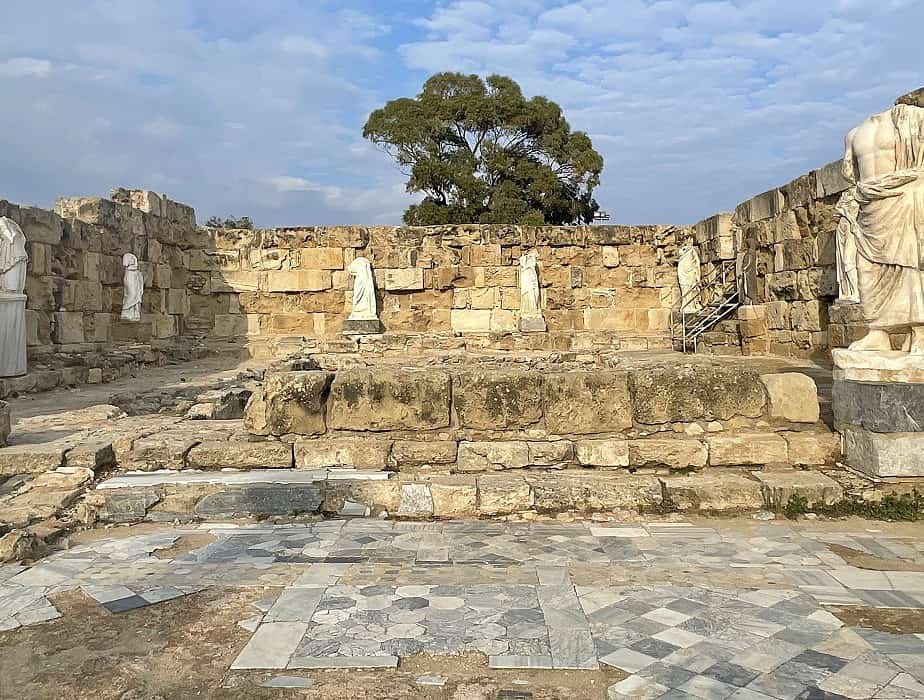Salamis in Cyprus – The Ancient City Of Ruins In Famagusta
Ancient Salamis in Cyprus is a reason alone to visit Northern Cyprus. Once the principal city of ancient Cyprus, in its heyday, it was the largest in Cyprus. These ruins boast some of the most impressive monuments on the island. While the city is in ruins, many original structures still stand, giving you an up-close look at early Greek life. The city’s remains, including a theater, gymnasium, and agora, can still be seen today. The ancient town is a UNESCO World Heritage site. If you are visiting Northern Cyprus, you should visit Ancient Salamis.

This post may contain affiliate links. Please read our disclosure and privacy policy for more information.
About Ancient Salamis, Cyprus
Salamis is an ancient city on the east coast of Cyprus. It was founded around 1180 BC by the legendary King Teucer (Teukros), Telamon’s son, Salamina’s king, on the Greek mainland. It became one of the most essential city-kingdoms of the eastern Mediterranean.
The city was renowned for its prosperity, wealth, and cultural achievements and was home to many impressive structures, including temples, theaters, and public buildings. In the early Christian period, Salamis became an important center of early Christianity and was the site of several important events in the life of the apostle Paul.
Today, the ruins of Salamis are a popular tourist attraction, attracting visitors from all over the world.
Cyprus Highlights
The Legend of Salamis
On the Greek mainland, Salamis was founded around 1180 BC by Teucer (Teukros), son of Telamon, king of Salamina. He could not avenge his brother’s death in the Trojan War, so he could not return home.
The History Of Salamis
Salamis came under Assyrian rule after its legendary beginnings; its first mention is on an Assyrian stele dated to 709 BC.
The town of Salamis was developed as a replacement for Engkomi when it was cut off from the sea, which suggests that the area had already been inhabited before the alleged arrival of Mycenaeans (at Enkomi). As a result, the foundation myth does not have much direct evidence to back it up.
Resistance to Persian Rule
Athens and the Persians fought simultaneously at Salamis in 450 BC. The Greek historian Herodotus and much later Greek orator Isocrates narrate the history of Salamis during the early Archaic and Classical periods.
Artaxerxes III later besieged and conquered Salamis. In the aftermath of Alexander the Great’s conquest of the Persian Empire, Ptolemy I of Egypt ruled Cyprus. Since he no longer trusted Nicocreon, the Ptolemaic governor of the island, he made him commit suicide in 311 BC. He was succeeded by his brother, Menelaus, who was the first Ptolemy. Near Enkomi is a large tumulus where Nicocreon is thought to be buried. The governor’s seat remained in Salamis.

The Submission
The city (and island) was submitted to the Persians after a land and sea battle in 450 BC. Despite Evagoras’ victory over the Persians, the city remained under Persian rule. Salamis flourished under his control. Greek thinkers and poets were welcomed to its thriving philosophical and literary scene. Alexander the Great ended Persian dominance over the city for a brief period. To quell uprisings in other Cypriot kingdoms after Alexander’s death, Nicocreon cooperated with the subsequent Ptolemaic rulers.
There is no explanation for Nicocreon’s death in 311 BC. He is said to have committed suicide in some texts, while others claim that he was murdered in others. Salamis began to flounder after Nicocreon’s death, despite Ptolemy’s rule lasting until 58 BC. Cyprus prospered again after becoming a Roman colony due to the rebuilding and construction of public works. As a result of two earthquakes and a tidal wave, Constantia was renamed Constantia and declared an Episcopal city in AD350. Like its predecessor, Constantine was also subject to Saracen Arab raids in the 7th and 8th centuries.
As a result, the city’s sluggish harbor became unusable and largely forgotten. As a result of this city’s stones, Famagusta was built later.
Touring Salamis
Historically, this city was home to a gymnasium, Roman baths with hot and cold plunge pools, public restrooms, a harbor, a temple to Zeus, and many other important buildings, including a Byzantine church. Aside from the paintings and statues, you can also see beautiful sculptures. During the Christian period of 400 A.D., many statues were defaced or damaged, in addition to other pagan and Roman elements.
Touring Salamis depends on how much of it you want to see. You can spend anywhere from an hour to a whole day. You can buy a ticket for about three euros or hire a guide. Lots of people take a day tour from Southern Cyprus to Northern Cyprus.
Map Of All The Ruins And Buildings Of Ancient Salamis In Cyprus
When you visit Salamis, you are given a minimal brochure, which does not include a comprehensive map. In addition, all of the signage at the site is sunbleached and barely legible. I suggest you print this map before heading there so you know which buildings you are looking at.
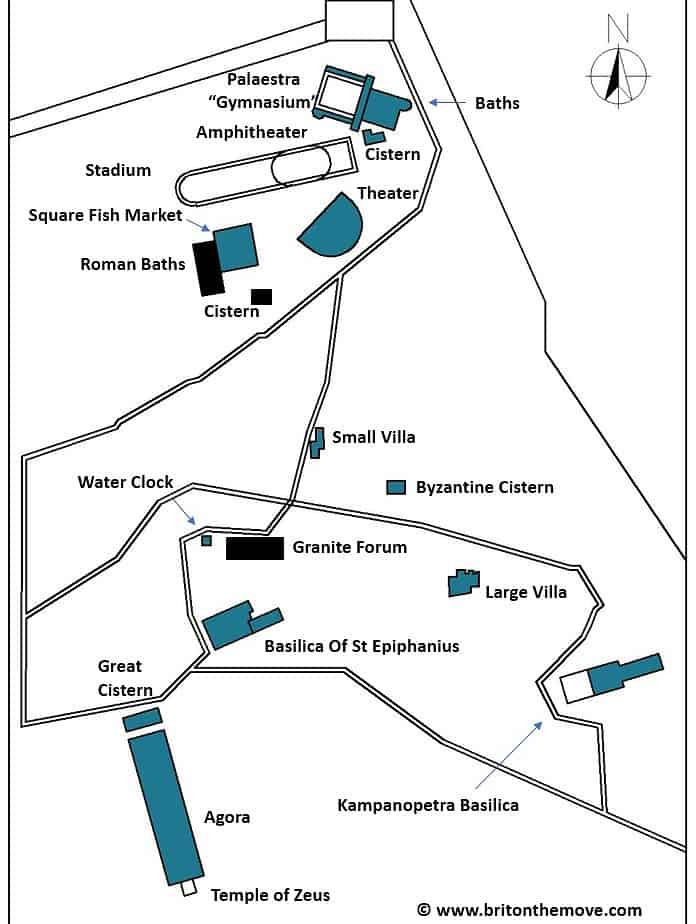
The Buildings Of Ancient Salamis In Cyprus
Here are the main buildings you can explore.
The Gymnasium
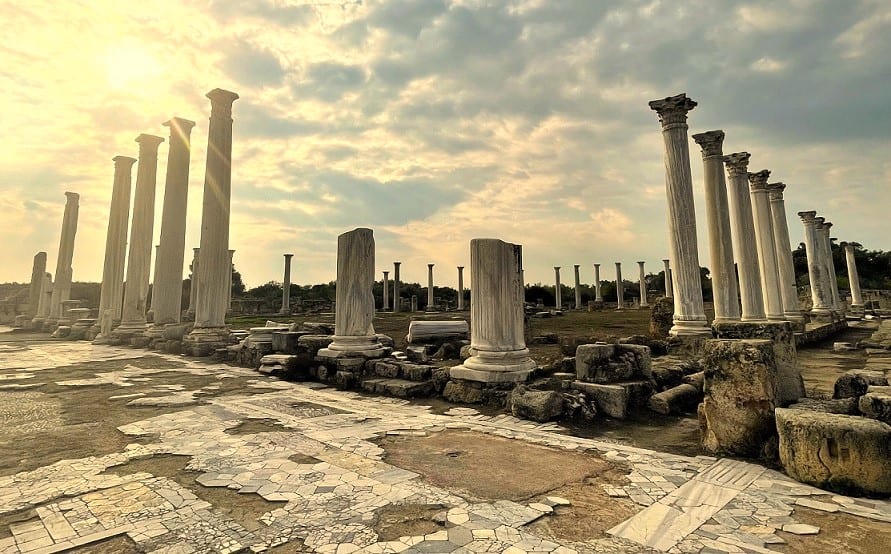
The gymnasium was a large rectangular building for athletics and education in ancient Salamis. The remains of the city’s gymnasium, with a courtyard full of columns and adjacent pools, allude to Salamis’ original grandeur. Its north entrance contains headless statues despoiled by Christian zealots as symbols of pagan worship.
Many that had survived numerous raids have disappeared since 1974. Fortunately, some made it to Nicosia’s Cyprus Museum and are now prized exhibits.
The Amphitheater
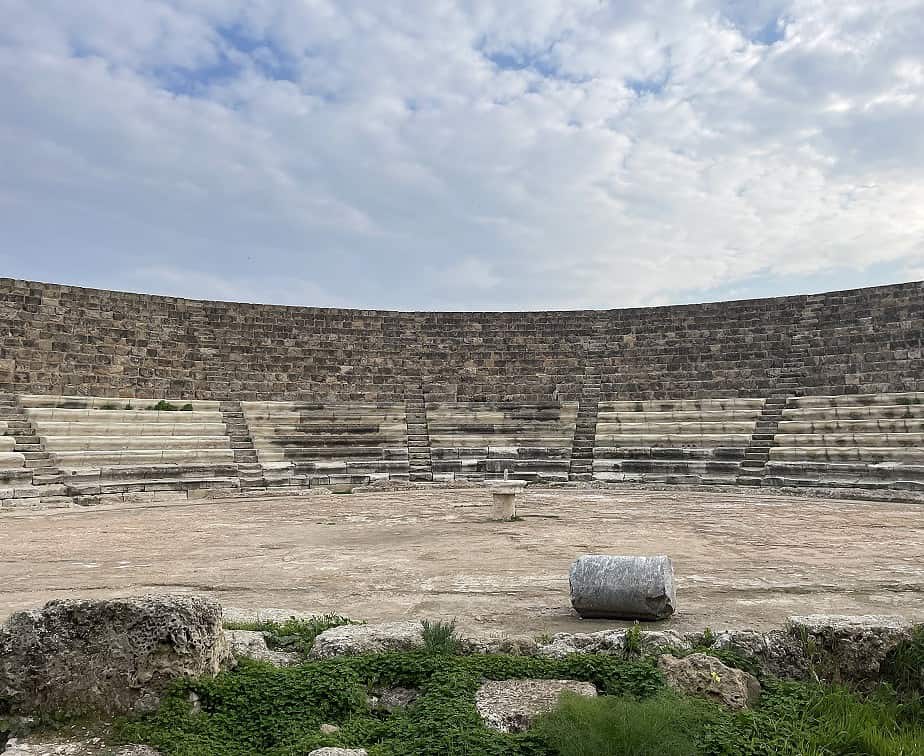
For most, this will be the highlight of the visit. No matter how many ancient cities or theaters you visit, they never get old. People are fascinated by these enormous structures that dominate the town.
The theatre once held 15,000 spectators from 31 BC to AD 14. After earthquakes destroyed much of it, stone raiders seized its blocks for use elsewhere. Occasionally, outdoor events are held there since it has been partially restored.
Note: You must be patient if you want a great photo here. There are lines of people waiting their turn in the off-season, and you’ll run into groups that seize the entire stage armed with remote control photography equipment. And most will keep going till they get “the perfect shot.” If you want to avoid this and have a chance to take a photo without the crowd, plan to get there as soon as it opens.
Kambanopetra Basilica

A basilica is a large oblong hall or building with double colonnades and a semicircular apse used in ancient Rome as a court of law or for public assemblies. This is where you’ll see the stunning columns overlooking the ocean.
These 4th-century remains are impressive. There is an intricate, well-preserved mosaic floor here, which can be found in the complex behind the church.
The Agora
An essential hub of commerce and trade, the agora was the central marketplace of Salamis. In addition to the basilica, bouleuterion, and shops, several other important public buildings are here.
What is a Bouleuterion?
In ancient Greece, bouleuterions meant council houses, assembly houses, and senate houses, which housed the council of citizens.
The Baths

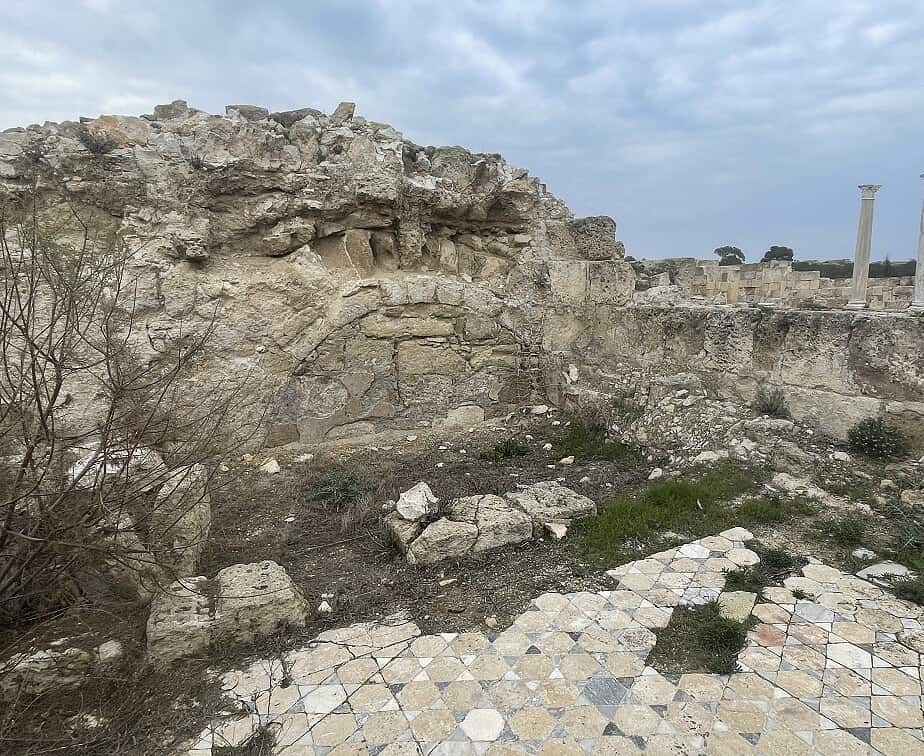
The baths were large, public bathhouses used for personal hygiene and relaxation. While the baths are not as intact or visual as some sections, you can tell from the layout that these were exotic and over-the-top baths.
You can see the exposed underfloor heating system in the Hellenistic and Roman baths east of the entrance.
A frescoed entrance to the south hall contains two of the site’s finest mosaics, dating from the 3rd and 4th centuries AD. You can see Leda and the Swan on one mosaic, and Apollo and Artemis combat the Niobids on the other. According to some, the last scene represents a battle between warriors and Amazons.
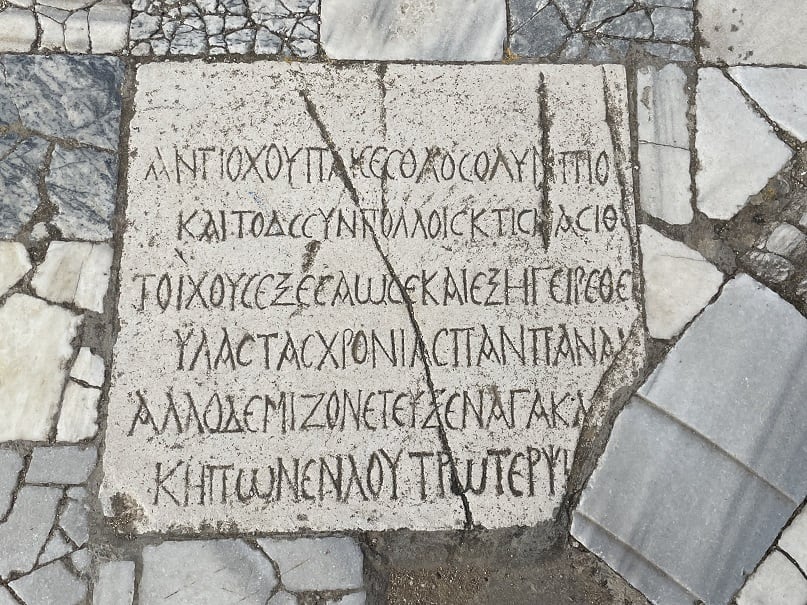
Roman Villa
South of the theatre, you will find the Roman villa. Almost everything is in ruin, so it isn’t easy to imagine when you see it. It’s also hard to find. Originally a two-story structure with a reception hall and a columned portico. The estate’s purpose was an olive oil mill that continued long after the city was abandoned. It is still possible to see the grinding stone today.
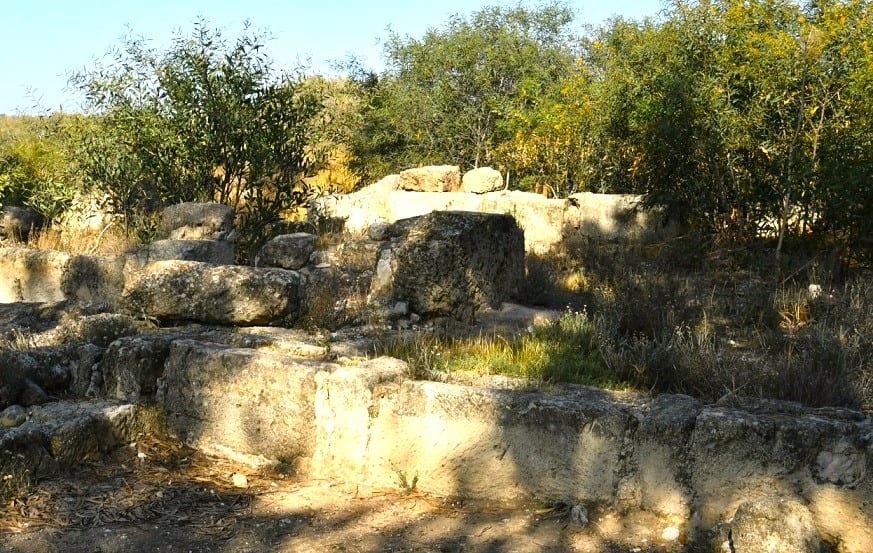
Reservoir
Ancient Salamis was particularly famous for its impressive reservoir, one of the largest water storage systems in the ancient world.
The reservoir was built during the Hellenistic period, around the 3rd century BCE. It was designed to provide the city with a reliable water source in a region where water was scarce. This reservoir was fed by underground channels that brought water from nearby hills and mountains.
The reservoir is a massive structure measuring 180 meters long, 15 meters wide, and 12 meters deep. It was lined with waterproof cement, which allowed it to hold up to 80,000 cubic meters of water.
Serving as a vital part of Salamis’ infrastructure, it was essential to the city’s prosperity. It enabled the town to support a large population and facilitated the growth of agriculture and industry. In times of drought or siege, the reservoir also served as a strategic asset, allowing the city to withstand prolonged periods without access to external water sources.
Today, you can view the remains of the Salamis reservoir in the archaeological site of the ancient city, offering a glimpse into the impressive engineering achievements of the ancient world.
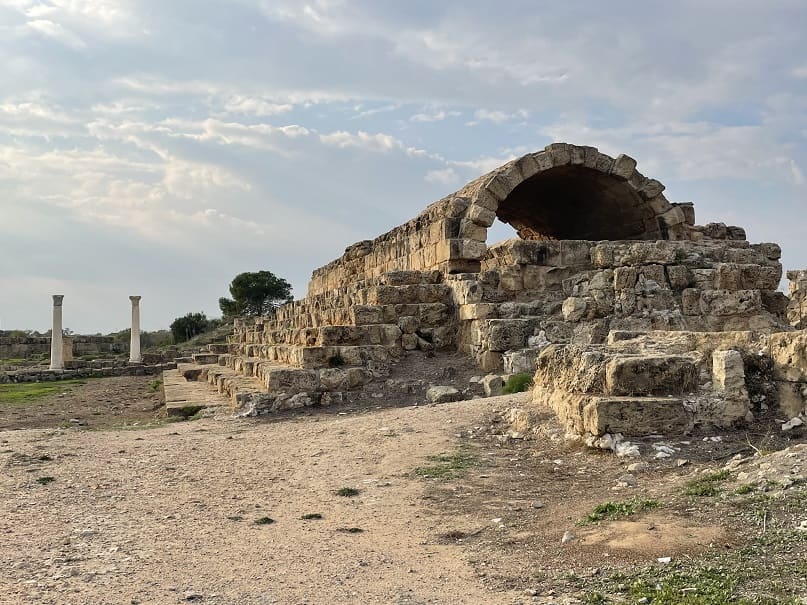
Temple of Zeus
The Temple of Zeus at Salamis was an ancient Greek religious site located on the island of Salamis in the Saronic Gulf. Built to honor the god Zeus, it is one of ancient Greece’s most important religious centers. A product of the 6th century BC, it was continuously in use until the 4th century AD. It comprises a temple, altars, a stadium, and other buildings and monuments.
It was a place of pilgrimage for Greeks from all over the Mediterranean world and was the site of many important religious festivals and games. The most important was the Salaminia, held every four years in honor of Zeus.
The temple is also the site of a famous battle between the Athenians and the Persians in 480 BC. The Athenians, led by Themistocles, defeated the Persian fleet in the nearby straits of Salamis, which secured their victory in the Greco-Persian Wars.
Important Buildings Outside of Salamis In Cyprus
The Necropolis
Located on the city’s outskirts, the Necropolis was an essential place for the people of Salamis. Numerous tombs and funerary monuments can be found there.
The Royal Tombs
A group of large, ornate tombs outside the city walls was believed to belong to Salamis’ royal family. Initially constructed in the 7th century BC, they are decorated with intricate frescoes.
FAQs
Where are the ruins of Salamis In Cyprus?
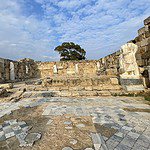
The ruins of Salamis are located in the modern-day country of Cyprus, near the city of Famagusta along the Famagusta-Boaz Highway.
Is Salamis in the north or south of Cyprus?
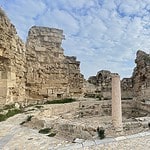
Salamis is in northern Cyprus, controlled by the Turkish Republic of Northern Cyprus (TRNC). The Republic of Cyprus holds the southern part of the island.
What is Salamis In Cyprus called now?

Salamis is an ancient Greek city-state located on the island of Salamis, near Athens.
The city no longer exists, and the island is now Salamina.
Where is Salamis in the Bible?
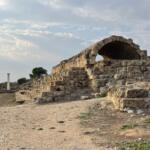
Salamis is in the New Testament of the Bible. In the book of Acts, chapter 13, verses 4-5, state:
“So, being sent out by the Holy Spirit, they went to Seleucia and sailed to Cyprus. And when they arrived in Salamis, they preached the word of God in the synagogues of the Jews.”
This passage describes the journey of Paul and Barnabas, whom the Holy Spirit sent to preach the word of God. They first traveled to the port city of Seleucia and then sailed to the island of Cyprus, where they arrived in Salamis and began preaching in the synagogues.
Closing Thoughts
Like Ancient Kourion, Salamis In Cyprus is vast and requires a few hours to explore it all. There are several sections of this ancient city to take in. You can easily visit Ancient Salamis from South Cyprus in a day – and you should!
Looking for more posts on Cyprus? Start here:
- 20 Plus Things to Do in Cyprus
- Adonis Baths Waterfall in Cyprus
- Ancient Kourion: Cyprus’ House of Eustolios
- Can You Fly to North Cyprus?
- Cyprus Border Crossing Between North and South Cyprus
- Kolossi Castle in Cyprus – A Hidden Gem
- North Cyprus – The Must-See Attractions!
We participate in the Amazon Services LLC Associates Program, an affiliate advertising program designed to provide a means for us to earn fees by linking to Amazon.com and affiliated sites.
Brit On The Move™ Travel Resources
Ready to book your next trip? Use these resources that work:
Was the flight canceled or delayed? Find out if you are eligible for compensation with AirHelp.
- Book your Hotel: Find the best prices; use Booking.com
- Find Apartment Rentals: You will find the best prices on apartment rentals with Booking.com’s Apartment Finder.
- Travel Insurance: Don’t leave home without it. View our suggestions to help you decide which travel insurance is for you: Travel Insurance Guide.
- Want to earn tons of points and make your next trip accessible? Check out our recommendations for Travel Credit Cards.
- Want To Take A Volunteer Vacation or a Working Holiday? Check out the complete guide to how here!
- Want to Shop For Travel Accessories? Check out our Travel Shop.
Need more help planning your trip? Visit our Resources Page, which highlights the great companies we use for traveling.
